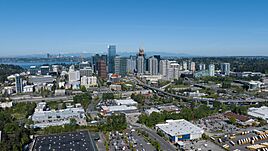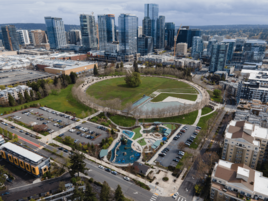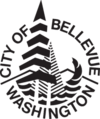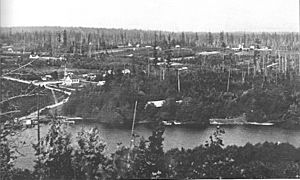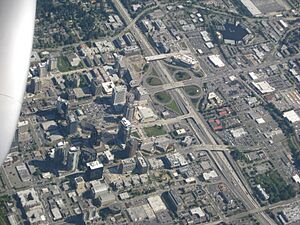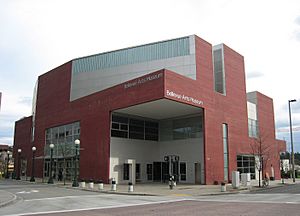Bellevue, Washington facts for kids
Quick facts for kids
Bellevue
|
||
|---|---|---|
|
Aerial view of Downtown Bellevue
Bellevue City Hall
Bellevue Square shopping center
Aerial view of Bellevue Downtown Park
|
||
|
||
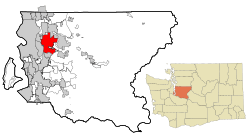
Location of Bellevue within King County, Washington, and of King County within Washington
|
||

U.S. Census map
|
||
| Country | United States | |
| State | Washington | |
| County | King | |
| Incorporated | March 31, 1953 | |
| Government | ||
| • Type | Council–manager | |
| • Body | Bellevue City Council | |
| Area | ||
| • City | 37.505 sq mi (97.138 km2) | |
| • Land | 33.468 sq mi (86.681 km2) | |
| • Water | 4.037 sq mi (10.455 km2) | |
| Elevation | 85 ft (26 m) | |
| Population
(2020)
|
||
| • City | 151,854 | |
| • Estimate
(2023)
|
151,574 | |
| • Rank | US: 178th WA: 5th |
|
| • Density | 4,530/sq mi (1,749/km2) | |
| • Urban | 3,544,011 (US: 13rd) | |
| • Metro | 4,044,837 (US: 15th) | |
| Time zone | UTC−8 (Pacific (PST)) | |
| • Summer (DST) | UTC−7 (PDT) | |
| ZIP Codes |
98004-98009
|
|
| Area code(s) | 425 | |
| FIPS code | 53-05210 | |
| GNIS feature ID | 1512000 | |
Bellevue (/ˈbɛlvjuː/ BEL-vew) is a city in Washington. It is located across Lake Washington from Seattle. Bellevue is the third-largest city in the Seattle metropolitan area. It is also the fifth-largest city in Washington state. The city's name comes from a French phrase, belle vue, which means "beautiful view."
Bellevue is home to many big technology companies. Its downtown area has changed a lot since 2008. Many tall buildings have been built there. Downtown Bellevue is now the second-largest city center in Washington. It has 1,300 businesses and 45,000 employees. About 10,200 people live there. In 2018, Bellevue was one of the top five cities in Washington for household income.
In 2008, CNNMoney said Bellevue was the best place to live and start a business. In 2010, it was ranked the fourth-best place to live in America. USA Today ranked Bellevue as the second-best place to live in 2014. Many companies have offices or headquarters in Bellevue. These include PACCAR Inc, T-Mobile US, and Valve. Amazon was even started in Bellevue by Jeff Bezos.
Contents
History of Bellevue
Early Settlements and European Arrival
The Duwamish people lived in this area long ago. They had a small village called Satskal near Mercer Slough. Another village, 'pah-pah-DEEL', was near Factoria.
European Americans first settled here in 1869. William Meydenbauer and Aaron Mercer were among the first. They claimed land several miles apart. Permanent residents arrived in 1879. By 1882, a community of logging families had formed. After the trees were cut, the land was cleared. Japanese immigrant workers helped clear the land in the early 1900s. They used it for small farms.
Bellevue as a Getaway Spot
In the early 1900s, Bellevue became a popular weekend spot. People from Seattle would take a ferry to Meydenbauer Bay. They would spend the day at Wildwood Park. When the ferry landing moved, fewer tourists came. To help, the Bellevue Strawberry Festival started in 1925. By the 1930s, it drew 15,000 visitors. At that time, Bellevue was a small town with about 2,000 people.
Growth and Development
Before 1940, Bellevue was mostly farms. But developers saw its potential. In the 1920s, James S. Ditty thought it would grow very big. He imagined bridges across Lake Washington. He also pictured golf courses and airports. His ideas were published on a map in 1928.
The Lake Washington Floating Bridge opened in 1940. This made it easier to get to Seattle. Bellevue then started to grow as a place where people lived and worked in other cities.
In 1942, the Strawberry Festival stopped. This was because many Japanese American farmers were forced to leave their homes. They were sent to special camps during World War II. The festival did not return for 45 years. After these families left, much farmland became open. This led to the first developments in downtown Bellevue.
Bellevue officially became a city on March 31, 1953. A second bridge, the Evergreen Point Floating Bridge, opened in 1963. After this, the city grew even faster. More areas like Crossroads and Lake Hills joined the city. By 1970, Bellevue was the fourth-largest city in Washington.
Today, Bellevue is still one of the state's largest cities. It has many tall buildings and a growing business community. The city saw a lot of new construction in the mid-2000s. Projects like Lincoln Square and the Bravern were built.
Bellevue Square is a large shopping center downtown. It opened in 1946. It has grown much bigger since the 1980s.
The city also plans to improve the Bel-Red Corridor. This area borders Redmond. The plan is to build new mixed-use areas. These will be like Lincoln Square. They will also include new transportation like the 2 Line light rail.
Geography of Bellevue
Bellevue is located between two lakes. Lake Washington is to the west. The smaller Lake Sammamish is to the east. Much of the city's water flows into Kelsey Creek. This creek starts near Larsen Lake and Phantom Lake. It flows into Lake Washington near Interstate 90.
The city is divided by Interstate 405. This highway runs north and south. Interstate 90 crosses the southern part of the city. Washington State Route 520 is another major freeway.
Bellevue covers about 37.5 square miles (97.1 square kilometers). About 33.5 square miles (86.7 square kilometers) is land. The rest is water.
The city's name means "beautiful view" in French. On clear days, you can see amazing views. You can see the Olympic Mountains and Cascade Mountains. These views are from hills and tall buildings in the city.
South of I-90, Bellevue goes up Cougar Mountain. The city also includes the Coal Creek, Somerset, and Factoria areas.
Neighboring Cities
Bellevue is surrounded by other cities. Kirkland is to the north. Redmond is to the northeast. Across the East Channel Bridge, I-90 connects Bellevue to Mercer Island to the southwest. Issaquah is to the east.
Many wealthy suburbs border Bellevue to the west. These include Medina, Clyde Hill, Hunts Point, and Yarrow Point. To the south, Bellevue borders Renton. To the southeast is Newcastle.
City Neighborhoods
Bellevue has many different neighborhoods. Some of these include Bellecrest, Bel-Red, Bridle Trails, Crossroads, Eastgate/Cougar Mountain, Enatai, Factoria, Lake Hills, Newport, Newport Hills, Northeast Bellevue, Northwest Bellevue, Overlake, Sammamish/East Bellevue, Somerset, Sunset, Tam O'Shanter, West Bellevue, Wilburton, and Woodridge.
Bellevue's Climate
Bellevue has a mild oceanic climate. It often rains from October to May. The city gets about 32 inches (813 mm) of rain each year. July is usually the hottest month. January is the coldest.
| Weather chart for Bellevue | |||||||||||||||||||||||||||||||||||||||||||||||
|---|---|---|---|---|---|---|---|---|---|---|---|---|---|---|---|---|---|---|---|---|---|---|---|---|---|---|---|---|---|---|---|---|---|---|---|---|---|---|---|---|---|---|---|---|---|---|---|
| J | F | M | A | M | J | J | A | S | O | N | D | ||||||||||||||||||||||||||||||||||||
|
4.5
43
32
|
3.7
47
35
|
3.8
54
38
|
2.8
58
42
|
2.1
65
47
|
1.7
70
52
|
1
77
55
|
1
78
57
|
1.7
71
52
|
3.3
60
46
|
4.9
52
40
|
5.5
44
34
|
||||||||||||||||||||||||||||||||||||
| temperatures in °F precipitation totals in inches |
|||||||||||||||||||||||||||||||||||||||||||||||
|
Metric conversion
|
|||||||||||||||||||||||||||||||||||||||||||||||
| Climate data for Bellevue, Washington | |||||||||||||
|---|---|---|---|---|---|---|---|---|---|---|---|---|---|
| Month | Jan | Feb | Mar | Apr | May | Jun | Jul | Aug | Sep | Oct | Nov | Dec | Year |
| Record high °F (°C) | 65 (18) |
70 (21) |
78 (26) |
89 (32) |
93 (34) |
108 (42) |
105 (41) |
100 (38) |
100 (38) |
90 (32) |
75 (24) |
64 (18) |
108 (42) |
| Mean daily maximum °F (°C) | 43 (6) |
47 (8) |
54 (12) |
58 (14) |
66 (19) |
70 (21) |
77 (25) |
78 (26) |
71 (22) |
60 (16) |
51 (11) |
44 (7) |
60 (16) |
| Mean daily minimum °F (°C) | 32 (0) |
35 (2) |
38 (3) |
42 (6) |
47 (8) |
52 (11) |
55 (13) |
57 (14) |
52 (11) |
46 (8) |
40 (4) |
34 (1) |
44 (7) |
| Record low °F (°C) | −5 (−21) |
−4 (−20) |
10 (−12) |
27 (−3) |
28 (−2) |
36 (2) |
42 (6) |
42 (6) |
35 (2) |
21 (−6) |
4 (−16) |
0 (−18) |
−5 (−21) |
| Average precipitation inches (mm) | 4.49 (114) |
3.67 (93) |
3.84 (98) |
2.84 (72) |
2.10 (53) |
1.68 (43) |
0.97 (25) |
0.97 (25) |
1.71 (43) |
3.32 (84) |
4.92 (125) |
5.45 (138) |
35.96 (913) |
Surrounding Areas Map
 |
Seattle | Kirkland | Redmond |  |
| Mercer Island | Sammamish | |||
| Renton | Newcastle | Issaquah |
Transportation in Bellevue
Bellevue is a major transportation hub. It serves the King County Metro bus system. It also serves Sound Transit, the regional transit system. The Bellevue Transit Center is downtown. It connects to Interstate 405.
Local buses go to nearby cities like Kirkland and Redmond. Regional buses connect to places like Seattle and Everett. A new electric shuttle service started in 2023. It is free for riders.
The 2 Line of Link light rail will run through Bellevue. It will connect Seattle to Redmond. This big project started building in 2016. The first part opened on April 27, 2024.
Bellevue's city leaders wanted the light rail to go underground downtown. The city agreed to help pay for it. Tunnel construction started in 2016.
The city is also planning a big project called "Bel-Red Area Transformation." This plan is for a large area in the north of the city. It will include new buildings and light rail.
Bellevue used to have a railroad line. It included the old Wilburton Trestle. This line is not used anymore. Part of it will be used for the light rail. A walking and biking trail, called Eastrail, is also being built on the old railroad path.
The city once had an airport called Bellevue Airfield. It closed in 1983.
Education in Bellevue
Most of Bellevue is served by the Bellevue School District. There are four main public high schools. These are Bellevue High School, Interlake High School, Newport High School, and Sammamish High School. There are also two special high schools: International School and Big Picture School.
Some parts of Bellevue are in other school districts. These include Lake Washington School District, Renton School District, and Issaquah School District.
For higher education, Bellevue has Bellevue College. This is part of the state's college system.
Bellevue also has private schools. Open Window School is for gifted students. The Jewish Day School of Metropolitan Seattle is also in Bellevue. There are several Montessori schools. Three Cedars School offers Waldorf education. Bellevue Christian School is another option. The Seattle Japanese School holds classes in Bellevue on weekends.
Economy of Bellevue
Bellevue is a major business center in the Seattle area. Many companies have their headquarters or U.S. offices here. Since 2005, it has become a hub for technology and software companies.
Companies based here include PACCAR Inc, T-Mobile US, Eddie Bauer, SAP Concur, and Symetra. Many big tech companies have offices in Bellevue. These include eBay, Meta, ByteDance, Oracle, Salesforce, Google, and Microsoft. Microsoft used to be headquartered in Bellevue. Now it is in nearby Redmond.
Famous video game companies are also in Bellevue. These include Valve, Bungie, Sucker Punch Productions, and The Pokémon Company International.
In 2019, Amazon and Facebook announced plans for big engineering centers in Bellevue. Google also opened a major engineering office in 2018. Many new tall office buildings are being built downtown. Some are part of a big Amazon campus. New tall apartment buildings are also planned. This is partly because of the new light rail service. As of 2024, Amazon has 12,000 employees in Bellevue.
Microsoft became the biggest employer in Bellevue in the late 2010s. They had many offices here. Other tech companies like ByteDance and The Pokémon Company International have also grown their offices in downtown Bellevue.
Top Employers in Bellevue
Here are the largest employers in Bellevue as of 2023:
| # | Employer | Type of Business | # of Employees | Percentage |
|---|---|---|---|---|
| 1 | Amazon | Online Retail | 11,000 | 6.62% |
| 2 | T-Mobile | Cellular Telephone | 5,200 | 3.13% |
| 3 | Meta | Online Social Network | 3,600 | 2.17% |
| 4 | Overlake Hospital Medical Center | Medical Hospital | 3,600 | 2.17% |
| 5 | Bellevue School District | Education K-12 | 2,800 | 1.68% |
| 6 | City of Bellevue | Government | 1,700 | 1.02% |
| 7 | Salesforce | Business Services | 1,500 | 0.90% |
| 8 | Smartsheet | Technology | 1,100 | 0.66% |
| 9 | Bellevue College | Higher Education | 1,000 | 0.60% |
| 10 | Bungie | Video Game Developer | 1,000 | 0.60% |
| — | Total employers | — | 32,500 | 19.55% |
Bellevue has many busy shopping areas. There are four main shopping centers. These are Bellevue Square downtown, Factoria Mall to the south, Crossroads Mall to the east, and the Overlake Shopping District to the north.
Bellevue's Population
| Historical population | |||
|---|---|---|---|
| Census | Pop. | %± | |
| 1900 | 254 | — | |
| 1910 | 150 | −40.9% | |
| 1920 | 1,213 | 708.7% | |
| 1930 | 1,071 | −11.7% | |
| 1940 | 1,177 | 9.9% | |
| 1950 | 7,658 | 550.6% | |
| 1960 | 12,809 | 67.3% | |
| 1970 | 61,196 | 377.8% | |
| 1980 | 73,903 | 20.8% | |
| 1990 | 86,874 | 17.6% | |
| 2000 | 109,569 | 26.1% | |
| 2010 | 122,363 | 11.7% | |
| 2020 | 151,854 | 24.1% | |
| 2023 (est.) | 151,574 | 23.9% | |
| U.S. Decennial Census 2020 Census |
|||
In 2018, about one in three Bellevue residents were born outside the United States. This is likely because of the many international tech companies. About 23% of Bellevue's workers are in engineering or science jobs. About half of its residents are people of color or from ethnic minority groups.
In 2018, the average household income in Bellevue was $113,698. A 2020 study found that Bellevue was first among small U.S. cities for active adults. 86% of adults said they exercise.
Population by Race and Ethnicity (2020)
| Race / Ethnicity (NH = Non-Hispanic) | Pop 2000 | Pop 2010 | Pop 2020 | % 2000 | % 2010 | % 2020 |
|---|---|---|---|---|---|---|
| White alone (NH) | 78,698 | 72,397 | 66,063 | 71.83% | 59.17% | 43.50% |
| Black or African American alone (NH) | 2,100 | 2,700 | 3,918 | 1.92% | 2.21% | 2.58% |
| Native American or Alaska Native alone (NH) | 301 | 349 | 255 | 0.27% | 0.29% | 0.17% |
| Asian alone (NH) | 19,011 | 33,659 | 61,539 | 17.35% | 27.51% | 40.53% |
| Pacific Islander alone (NH) | 248 | 219 | 254 | 0.23% | 0.18% | 0.17% |
| Other race alone (NH) | 261 | 342 | 821 | 0.24% | 0.28% | 0.54% |
| Mixed Race or Multi-Racial (NH) | 3,123 | 4,152 | 7,933 | 2.85% | 3.39% | 5.22% |
| Hispanic or Latino (any race) | 5,827 | 8,545 | 11,071 | 5.32% | 6.98% | 7.29% |
| Total | 109,569 | 122,363 | 151,854 | 100.00% | 100.00% | 100.00% |
In 2020, Bellevue had 151,854 people. There were 60,953 households. The city's population density was about 4,538 people per square mile. The racial makeup was 44.7% White, 2.6% African American, and 40.6% Asian. People of Hispanic or Latino background made up 7.3% of the population. About 20% of residents were under 18 years old.
Arts and Culture in Bellevue
Cultural Events to Enjoy
Bellevue hosts the annual Bellevue Arts and Crafts Fair. It has been held since 1947. It takes place during the last weekend of July.
The Bellevue Sculpture Exhibition happens every two years. It brings thousands of visitors to the Bellevue Downtown Park. They come to see up to 46 amazing sculptures.
To celebrate its history, Bellevue has an annual Strawberry Festival. It is held on the fourth weekend of June at Crossroads Park. The festival started in 1925. It stopped in 1942 when many strawberry farmers were forced to leave. The festival returned in 1987. In 2003, it became a multi-day event again.
Bellevue also hosts the Northwest Ukrainian International Festival. It started in 2017. It is one of the biggest Ukrainian culture festivals in the U.S. The Grand Kyiv Ballet has been based in Bellevue since 2022.
Interesting Places to Visit
The Bellevue Arts Museum first opened in 1975. It moved to its own building in 2001. After some financial challenges, it reopened in 2005. Now it focuses on craft and design art.
The Rosalie Whyel Museum of Doll Art used to be here. It had one of the world's largest doll collections. It is now the home of the KidsQuest Children's Museum.
Near Interstate 405 is Meydenbauer Center. This is a convention center. It hosts business meetings and charity events. Meydenbauer also has a theater. It holds operas, ballets, and orchestra shows.
The city plans to build a performing arts center. It will be called the Tateuchi Center. It will have a 2,000-seat concert hall. This project is partly funded by donations and city grants.
Sports and Recreation Fun
Since the 1970s, Bellevue has worked to protect its natural areas. The Parks and Community Services Department manages over 2,500 acres of parks. This includes the Downtown Park and the Bellevue Botanical Garden. There are also playgrounds, beach parks, and trails. More than 5,500 people volunteer with this department each year.
Bellevue was home to a basketball team called the Bellevue Blackhawks. They played in the American Basketball Association. The team made it to the championship game in 2005. They have not been active since 2006.
The city has a small baseball stadium called Bannerwood Park. It can hold 700 fans. The Seattle Redhawks college baseball team plays their home games here.
Notable People from Bellevue
Bellevue has been home to many famous people:
- William S. Ayer, former CEO of Alaska Airlines
- Ricky Horror, guitarist for Motionless in White
- Peter Horton, actor
- James Love, Director of Knowledge Ecology International
- Rob McKenna, former Attorney General of Washington
- Satya Nadella, CEO of Microsoft
- Gabe Newell, owner of Valve
- Timothy Omundson, actor
- Layne Staley, former lead singer of Alice in Chains
- Ann Reinking, Broadway actress and dancer
- Larry Sanger, Wikipedia co-founder
- Ann Wilson, co-founder of Heart
- Nancy Wilson, co-founder of Heart
Athletes, Coaches, and Sportscasters
- Budda Baker, professional football player
- Sue Bird, former basketball player for Seattle Storm
- Michael Brantley, MLB outfielder
- Matthew Boyd, MLB pitcher
- Matt Hague, former MLB first baseman
- Tim Lincecum, former MLB pitcher
- Fredy Montero, MLS player
- Dave Niehaus, former baseball broadcaster
- John Olerud, former MLB player
- Megan Rapinoe, soccer player for Seattle Reign FC and USWNT
- Detlef Schrempf, former NBA player
- Matthew Sheldon, professional soccer player
- Robert Stock, MLB player
- Chuck Swirsky, NBA broadcaster
- Matt Tuiasosopo, former professional baseball player
Sister Cities of Bellevue
Bellevue has friendly relationships with these cities around the world:
 Hualien, Taiwan
Hualien, Taiwan Yao, Osaka Prefecture, Japan
Yao, Osaka Prefecture, Japan Kladno, Czech Republic
Kladno, Czech Republic Liepāja, Latvia
Liepāja, Latvia
See also
 In Spanish: Bellevue (Washington) para niños
In Spanish: Bellevue (Washington) para niños


